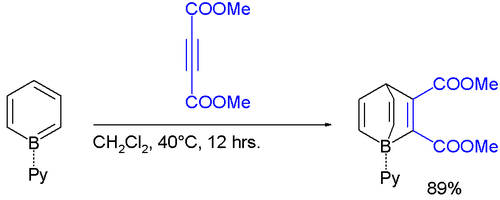Borabenzene
Appearance

| |
| Names | |
|---|---|
| Preferred IUPAC name
Borinine | |
| Identifiers | |
3D model (
JSmol ) |
|
| ChemSpider | |
PubChem CID
|
|
CompTox Dashboard (EPA)
|
|
| |
| |
| Properties | |
| C5H5B | |
| Molar mass | 75.91 g·mol−1 |
Except where otherwise noted, data are given for materials in their standard state (at 25 °C [77 °F], 100 kPa).
| |
Borabenzene is a hypothetical
organoboron compound with the formula C5H5B. Unlike the related but highly stable benzene molecule, borabenzene would be electron-deficient. Related derivatives are the boratabenzene
anions, including the parent [C5H5BH]−.
Adducts
Adducts of borabenzene with
Lewis bases
are isolatable. Since borabenzene is unavailable, these adducts require indirect methods. 4-Silyl-1-methoxyboracyclohexadiene is used as a precursor to the borabenzene:
- C
5H
5N + MeOBC
5H
5SiMe
3 → C
5H
5N-BC
5H
5 + MeOSiMe3
The pyridine adduct C
5H
5N-BC
5H
5 is structurally related to biphenyl.[1] It is a yellow whereas biphenyl is colorless, indicating distinct electronic structures. The pyridine ligand is tightly bound: no exchange is observed with free pyridine, even at elevated temperatures.
The borabenzene-pyridine adduct behaves like a
Diels-Alder reactions.[2]
See also
- 6-membered aromatic rings with one carbon replaced by another group:
- Borazine
References
- .
- PMID 16774279.


